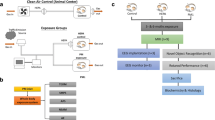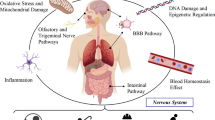Abstract
PM2.5-related neurological and mental diseases, such as cognitive impairment and stroke, tend to cause disability. Six-week-old male C57BL/6 mice were divided into 6 groups and exposed to concentrated PM2.5 or filtered air for 2, 4, and 6 months, respectively. The neurobehavioral changes of mice were tested. The weight of the whole brain and olfactory bulbs were recorded at the end of exposure, and the brain structure was observed by hematoxylin and eosin (HE) staining. Serum indicators, mRNA, and protein expressions were detected. The spatial learning memory ability was impaired, and the mice were more anxious after PM2.5 exposure. Relative brain weight decreased with age, and PM2.5 exposure exceeded the decrease of relative brain weight. Interestingly, superoxide dismutase (SOD) and albumin decreased in the PM2.5-exposed groups although neuronal morphology and other serum indicators did not show significant difference between PM and FA groups. Moreover, PM2.5 induced the increase of plasminogen at 2 months but recovered at 4 months and then increased at 6 months again. The results from protein expression and transcriptomic test demonstrated that PI3K/AKT/FoxO1 pathway might be activated after 6-month PM2.5 exposure in mice. Indicators albumin, the percentage of albumin over IgG (A/G value), and plasminogen were the main serous changes in mice after early-stage (2 months) and long-term (6 months) PM2.5 exposure. In addition, early-stage injury induced by PM2.5 might recover at later time point and display significant injury again with the exposure time. PM2.5 exposure-induced brain injury might be associated with the activation of PI3K/AKT/FoxO1 pathway.






Similar content being viewed by others
Availability of data and materials
The data that support the findings of this study are available, but restrictions apply to the availability of these data. Data are however available from the authors upon reasonable request.
Abbreviations
- PM2.5 :
-
Fine particulate matter
- DALYs:
-
Disability-adjusted life years
- FA:
-
Filtered air
- SIR:
-
Systemic inflammatory response
- BDNF:
-
Brain-derived neurotrophic factor
- miRNA:
-
microRNA
- FoxO:
-
Forkhead box O
- PI3K:
-
Phosphatidylinositol 3-kinase
- Akt:
-
Protein kinase B
- NGF:
-
Nerve growth factor
- HSA:
-
Human serum albumin
- PAI-1:
-
Plasminogen activator inhibitor 1
- Shanghai-METAS:
-
Shanghai Meteorological and Environmental Animal Exposure System
- HE:
-
Hematoxylin and eosin
- FPKM:
-
Fragments per kilobase of exon per million mapped reads
- PCA:
-
Principal component analysis
- IL:
-
Interleukin
- TNF-α:
-
Tumor necrosis factor α
- SOD:
-
Superoxide dismutase
- ROS:
-
Reactive oxygen species
- RT-PCR:
-
Real-time PCR
- ANOVA:
-
One-way analysis of variance
References
Arden KC (2004) FoxO: linking new signaling pathways. Mol Cell 14(4):416–418. https://doi.org/10.1016/s1097-2765(04)00213-8
Baltanas FC, Weruaga E, Valero J, Recio JS, Alonso JR (2009) Albumin attenuates DNA damage in primary-cultured neurons. Neurosci Lett 450(1):23–26. https://doi.org/10.1016/j.neulet.2008.10.108
Bos I, De Boever P, Int Panis L, Sarre S, Meeusen R (2012) Negative effects of ultrafine particle exposure during forced exercise on the expression of Brain-Derived Neurotrophic Factor in the hippocampus of rats. Neuroscience 223:131–139. https://doi.org/10.1016/j.neuroscience.2012.07.057
Chao MW, Yang CH, Lin PT, Yang YH, Chuang YC, Chung MC, Tseng CY (2017) Exposure to PM2.5 causes genetic changes in fetal rat cerebral cortex and hippocampus. Environ Toxicol 32(4):1412–1425. https://doi.org/10.1002/tox.22335
Chen S, Li D, Wu X, Chen L, Zhang B, Tan Y, Yu D, Niu Y, Duan H, Li Q, Chen R, Aschner M, Zheng Y, Chen W (2020) Application of cell-based biological bioassays for health risk assessment of PM2.5 exposure in three megacities, China. Environ Int 139:105703. https://doi.org/10.1016/j.envint.2020.105703
Collaborators GBDRF (2018) Global, regional, and national comparative risk assessment of 84 behavioural, environmental and occupational, and metabolic risks or clusters of risks for 195 countries and territories, 1990-2017: a systematic analysis for the Global Burden of Disease Study 2017. Lancet 392(10159):1923–1994. https://doi.org/10.1016/S0140-6736(18)32225-6
Costa LG, Cole TB, Coburn J, Chang YC, Dao K, Roque PJ (2017) Neurotoxicity of traffic-related air pollution. Neurotoxicology 59:133–139. https://doi.org/10.1016/j.neuro.2015.11.008
Du XH, Jiang S, Zeng XJ, Zhang J, Pan K, Zhou J, Xie YQ, Kan HD, Song WM, Sun QH, Zhao JZ (2018) Air pollution is associated with the development of atherosclerosis via the cooperation of CD36 and NLRP3 inflammasome in ApoE(-/-) mice. Toxicology Letters 290:123–132. https://doi.org/10.1016/j.toxlet.2018.03.022
Fagundes LS, Fleck A d S, Zanchi AC, Saldiva PHN, Rhoden CR (2015) Direct contact with particulate matter increases oxidative stress in different brain structures. Inhalation toxicology 27(10):462–467
Guan L, Rui W, Bai R, Zhang W, Zhang F, Ding W (2016) Effects of size-fractionated particulate matter on cellular oxidant radical generation in human bronchial epithelial BEAS-2B Cells. Int J Environ Res Public Health 13(5). https://doi.org/10.3390/ijerph13050483
Hameed S, Zhao J, Zare RN (2020) Ambient PM particles reach mouse brain, generate ultrastructural hallmarks of neuroinflammation, and stimulate amyloid deposition, tangles, and plaque formation. Talanta Open 2:100013
Heusinkveld HJ, Wahle T, Campbell A, Westerink RH, Tran L, Johnston H, Stone V, Cassee FR, Schins RP (2016) Neurodegenerative and neurological disorders by small inhaled particles. Neurotoxicology 56:94–106
Ji X, Yue H, Ku T, Zhang Y, Yun Y, Li G, Sang N (2019) Histone modification in the lung injury and recovery of mice in response to PM2.5 exposure. Chemosphere 220:127–136. https://doi.org/10.1016/j.chemosphere.2018.12.079
Jiang S, Zhou J, Zhang J, Du X, Zeng X, Pan K, Xie Y, Kan H, Sun Q, Cai J, Zhao J (2018) The severity of lung injury and metabolic disorders induced by ambient PM2.5 exposure is associated with cumulative dose. Inhal Toxicol 30(6):239–246. https://doi.org/10.1080/08958378.2018.1508258
Kandeil MA, Mohammed ET, Hashem KS, Aleya L, Abdel-Daim MM (2020) Moringa seed extract alleviates titanium oxide nanoparticles (TiO2-NPs)-induced cerebral oxidative damage, and increases cerebral mitochondrial viability. Environ Sci Pollut Res Int 27(16):19169–19184. https://doi.org/10.1007/s11356-019-05514-2
Kioumourtzoglou MA, Schwartz JD, Weisskopf MG, Melly SJ, Wang Y, Dominici F, Zanobetti A (2016) Long-term PM2.5 exposure and neurological hospital admissions in the Northeastern United States. Environ Health Perspect 124(1):23–29. https://doi.org/10.1289/ehp.1408973
Klotz LO, Sanchez-Ramos C, Prieto-Arroyo I, Urbanek P, Steinbrenner H, Monsalve M (2015) Redox regulation of FoxO transcription factors. Redox Biol 6:51–72. https://doi.org/10.1016/j.redox.2015.06.019
Liu X, Qian X, Xing J, Wang J, Sun Y, Wang Q, Li H (2018) Particulate matter triggers depressive-like response associated with modulation of inflammatory cytokine homeostasis and brain-derived neurotrophic factor signaling pathway in mice. Toxicol Sci 164(1):278–288. https://doi.org/10.1093/toxsci/kfy086
Maher BA, Ahmed IA, Karloukovski V, MacLaren DA, Foulds PG, Allsop D, Mann DM, Torres-Jardon R, Calderon-Garciduenas L (2016) Magnetite pollution nanoparticles in the human brain. Proc Natl Acad Sci U S A 113(39):10797–10801. https://doi.org/10.1073/pnas.1605941113
Matsumoto M, Accili D (2005) All roads lead to FoxO. Cell metabolism 1(4):215–216
Nascetti S, Elosua R, Pena A, Covas MI, Senti M, Marrugat J, Investigators R (2001) Variables associated with fibrinogen in a population-based study: interaction between smoking and age on fibrinogen concentration. Eur J Epidemiol 17(10):953–958. https://doi.org/10.1023/a:1016216808365
Oberdorster G, Sharp Z, Atudorei V, Elder A, Gelein R, Kreyling W, Cox C (2004) Translocation of inhaled ultrafine particles to the brain. Inhal Toxicol 16(6-7):437–445. https://doi.org/10.1080/08958370490439597
Pan K, Jiang S, Du X, Zeng X, Zhang J, Song L, Zhou J, Kan H, Sun Q, Xie Y, Zhao J (2019) AMPK activation attenuates inflammatory response to reduce ambient PM2.5-induced metabolic disorders in healthy and diabetic mice. Ecotoxicol Environ Saf 179:290–300. https://doi.org/10.1016/j.ecoenv.2019.04.038
Qiu H, Sun S, Tsang H, Wong CM, Lee RS, Schooling CM, Tian L (2017) Fine particulate matter exposure and incidence of stroke: a cohort study in Hong Kong. Neurology 88(18):1709–1717. https://doi.org/10.1212/WNL.0000000000003903
Rui W, Guan L, Zhang F, Zhang W, Ding W (2016) PM2.5-induced oxidative stress increases adhesion molecules expression in human endothelial cells through the ERK/AKT/NF-kappaB-dependent pathway. J Appl Toxicol 36(1):48–59. https://doi.org/10.1002/jat.3143
Saenen ND, Plusquin M, Bijnens E, Janssen BG, Gyselaers W, Cox B, Fierens F, Molenberghs G, Penders J, Vrijens K, De Boever P, Nawrot TS (2015) In utero fine particle air pollution and placental expression of genes in the brain-derived neurotrophic factor signaling pathway: an ENVIRONAGE birth cohort study. Environ Health Perspect 123(8):834–840. https://doi.org/10.1289/ehp.1408549
Shah AS, Lee KK, McAllister DA, Hunter A, Nair H, Whiteley W, Langrish JP, Newby DE, Mills NL (2015) Short term exposure to air pollution and stroke: systematic review and meta-analysis. BMJ 350:h1295. https://doi.org/10.1136/bmj.h1295
Sunyer J, Esnaola M, Alvarez-Pedrerol M, Forns J, Rivas I, Lopez-Vicente M, Suades-Gonzalez E, Foraster M, Garcia-Esteban R, Basagana X, Viana M, Cirach M, Moreno T, Alastuey A, Sebastian-Galles N, Nieuwenhuijsen M, Querol X (2015) Association between traffic-related air pollution in schools and cognitive development in primary school children: a prospective cohort study. PLoS Med 12(3):e1001792. https://doi.org/10.1371/journal.pmed.1001792
Svennerholm L, Bostrom K, Jungbjer B (1997) Changes in weight and compositions of major membrane components of human brain during the span of adult human life of Swedes. Acta Neuropathol 94(4):345–352. https://doi.org/10.1007/s004010050717
Thompson AM, Zanobetti A, Silverman F, Schwartz J, Coull B, Urch B, Speck M, Brook JR, Manno M, Gold DR (2010) Baseline repeated measures from controlled human exposure studies: associations between ambient air pollution exposure and the systemic inflammatory biomarkers IL-6 and fibrinogen. Environ Health Perspect 118(1):120–124. https://doi.org/10.1289/ehp.0900550
Tzivion G, Hay N (2011) PI3K-AKT-FoxO axis in cancer and aging. Biochim Biophys Acta 1813(11):1925. https://doi.org/10.1016/j.bbamcr.2011.08.014
Vicario C, Tabernero A, Medina JM (1993) Regulation of lactate metabolism by albumin in rat neurons and astrocytes from primary culture. Pediatric research 34(6):709–715
Vorhees CV, Williams MT (2006) Morris water maze: procedures for assessing spatial and related forms of learning and memory. Nat Protoc 1(2):848–858. https://doi.org/10.1038/nprot.2006.116
Walf AA, Frye CA (2007) The use of the elevated plus maze as an assay of anxiety-related behavior in rodents. Nat Protoc 2(2):322–328. https://doi.org/10.1038/nprot.2007.44
Wang LJ, Guo CL, Li XQ, Wang SY, Jiang B, Zhao Y, Luo J, Xu K, Liu H, Guo SJ, Wu N, Shi DY (2017) Discovery of novel bromophenol hybrids as potential anticancer agents through the ros-mediated apoptotic pathway: design. synthesis and biological evaluation. Mar Drugs 15(11). https://doi.org/10.3390/md15110343
Wilker EH, Preis SR, Beiser AS, Wolf PA, Au R, Kloog I, Li W, Schwartz J, Koutrakis P, DeCarli C, Seshadri S, Mittleman MA (2015) Long-term exposure to fine particulate matter, residential proximity to major roads and measures of brain structure. Stroke 46(5):1161–1166. https://doi.org/10.1161/STROKEAHA.114.008348
Zhang M, Liu W, Zhou Y, Li Y, Qin Y, Xu Y (2018) Neurodevelopmental toxicity induced by maternal PM2.5 exposure and protective effects of quercetin and Vitamin C. Chemosphere 213:182–196. https://doi.org/10.1016/j.chemosphere.2018.09.009
Zhu YN, Lu SM, You JF, Zhu B, Yu MY (2009) Novel real-time PCR assay for rapid prenatal diagnosis of Down syndrome: a prospective study of 563 amniocytes. Clin Biochem 42(7-8):672–675. https://doi.org/10.1016/j.clinbiochem.2009.02.004
Funding
This study was financially supported by the National Key Research and Development Program of China (2017YFC0211602) and the National Natural Science Foundation of China (No. 81673125 and 91543119).
Author information
Authors and Affiliations
Contributions
LYS designed and performed the experiment and wrote the paper. KP performed the experiment and analyzed the data. XHD, SJ, XJZ, JZ, LL, DXF, ZXL, MDZ, and YWZ performed the experiment. JZ provide technical support of the exposure equipment. JZZ designed the experiment and revised the paper. All authors read and approved the final manuscript.
Corresponding author
Ethics declarations
Ethics approval and consent to participate
The study was approved by the Fudan University Animal Care and Use Committee, and all animal procedures were treated in accordance with the National Institutes of Health Guide for the Care and Use of Laboratory Animals. The approval number was 201902063S.
Consent for publication
Not applicable
Competing interests
The authors declare no competing interests.
Additional information
Responsible Editor: Mohamed M. Abdel-Daim
Publisher’s note
Springer Nature remains neutral with regard to jurisdictional claims in published maps and institutional affiliations.
Supplementary information
ESM 1
(DOCX 1255 kb)
Rights and permissions
About this article
Cite this article
Song, L., Pan, K., Du, X. et al. Ambient PM2.5-induced brain injury is associated with the activation of PI3K/AKT/FoxO1 pathway. Environ Sci Pollut Res 28, 68276–68287 (2021). https://doi.org/10.1007/s11356-021-15405-0
Received:
Accepted:
Published:
Issue Date:
DOI: https://doi.org/10.1007/s11356-021-15405-0




